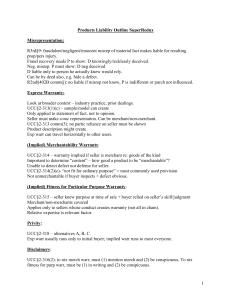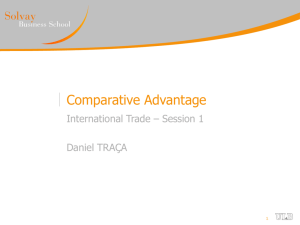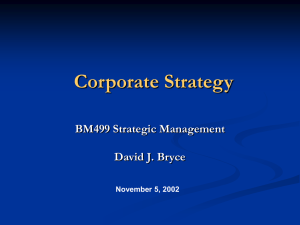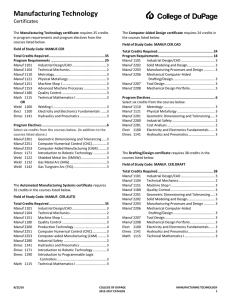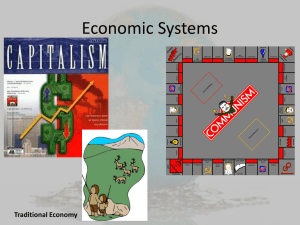Competing in Global Value Chains Implications for Jobs and Income
advertisement
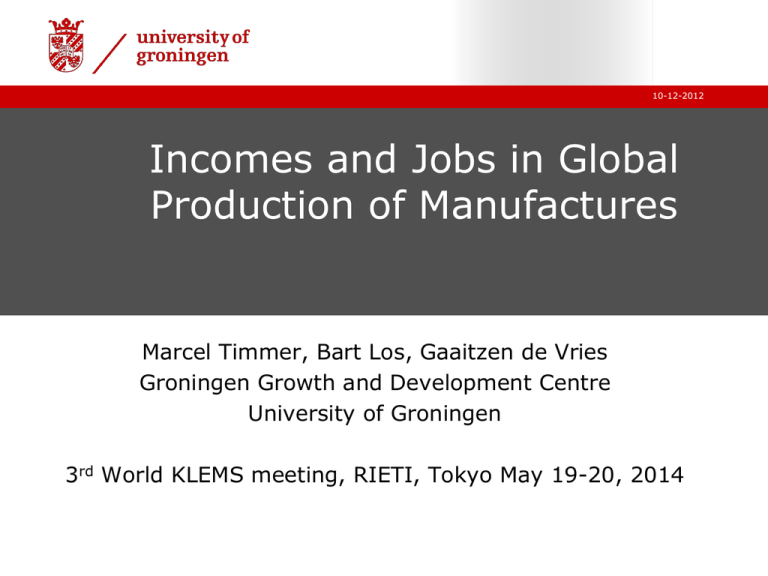
10-12-2012 Incomes and Jobs in Global Production of Manufactures Marcel Timmer, Bart Los, Gaaitzen de Vries Groningen Growth and Development Centre University of Groningen 3rd World KLEMS meeting, RIETI, Tokyo May 19-20, 2014 Background and motivation 10-12-2012 > Due to international fragmentation of production standard measures of competitiveness, such as gross exports, become less informative. > International competition increasingly plays out at the level of activities within industries, rather than at the level of whole industries or products > This paper introduces two new measures based on activities that add value in the global production of final manufacturing goods: GVC income and GVC jobs. > We outline these concepts and provide trends based on a recent multi-sector input-output model of the world economy (the World Input-Output Database) Prelims 10-12-2012 > A global value chain (GVC) is identified by the country-industry in which the last production stage takes place (e.g. Sweden transport equipment manufacturing). > Focus on GVCs of manufactures which includes the value of all activities involved in the production of final manufacturing goods. Note that this includes activities in both manufacturing and non-manufacturing sectors (materials, services). Note that factors are recorded on a domestic (location), not a national (ownership) basis. > It does not measure competitiveness in manufacturing (it excludes manufacturing value added for non-manufacturing final products), nor competitiveness in international trade (as it includes final domestic demand, and excludes part of nonmanufacturing trade) Factor content of a global value chain: graphical representation 10-12-2012 Country 1 Capital and labour Intermediate goods Foreign value added Domestic intermediate goods Country 2 Capital and labour Country 3 Capital and labour Final goods for domestic and foreign demand VA by L2 VA by K2 Intermediate goods Domestic intermediate goods VA by L1 VA by K1 Domestic value added VA by L3 VA by K3 10-12-2012 Value added share in Swedish transport equipment manufacturing (%) 10-12-2012 GVC jobs: workers directly and indirectly involved in the production of Swedish transport equipment manufacturing goods What is in the World Input-Output Database (WIOD)? 10-12-2012 Sweden Japan USA Sweden Japan USA Tot M ··· S ··· C M ··· S ··· C M ··· S ··· C H I G H I G H I G Sweden Mining ····· Steel manuf ····· Car manuf Japan Mining ····· Steel manuf ····· Car manuf USA Mining ····· Steel manuf ····· Car manuf Value added Total • • • • • • • • • • • • • • • • • • • • • • • • • • • • • • • • • • • • • • • • • • • • • • • • • • • • • • • • • • • • • • • • • • • • • • • • • • • • • • • • • • • • • • • • • • • • • • • • • • • • • • • • • • • • • • • • • • • • • • • • • • • • • • • • • • • • • • • • • • • • • • • • • • • • • • • • • • • • • • • • • • • • • • • • • • • • • • • • • • • • • • • • • • • • • • • • • • • • • • • • • • • • • • • • • • • • • • • • • • • • • • • • • • • • • • • • • • • • • • • • • • • • • • • • • • • • • • • • • • • • • • • • • • • • • • • • • • • • • • • • • • • • • • • • • • • • • • • • • • • • • • • • • • • • • • • • • • • • • • • • • • • • • • • • • • • • • • • • • • • • • • • • • • • • • • • • • • • • • • • • • • • • • • • • • • • • • • • • • • • • • • • • • • • • • • • • • • • • • • • • • • • • • World input-output tables Global Value Chain in a WIOT 10-12-2012 Sweden Japan USA Sweden Japan USA Tot M ··· S ··· C M ··· S ··· C M ··· S ··· C H I G H I G H I G Sweden Mining ····· Steel manuf ····· Car manuf Japan Mining ····· Steel manuf ····· Car manuf USA Mining ····· Steel manuf ····· Car manuf Value added Total Employment CO2 emissions • • • • • • • • • • • • • • • • • • • • • • • • • • • • • • • • • • • • • • • • • • • • • • • • • • • • • • • • • • • • • • • • • • • • • • • • • • • • • • • • • • • • • • • • • • • • • • • • • • • • • • • • • • • • • • • • • • • • • • • • • • • • • • • • • • • • • • • • • • • • • • • • • • • • • • • • • • • • • • • • • • • • • • • • • • • • • • • • • • • • • • • • • • Swedish • • • •exports • • of • cars require: production in Swedish car manufacturing • • • • • • • • • • • • • • • • • • • • • • • • • • • • • • • • • • • • • • • • • • • • • • • • • • • • • • • • • • • • • • • • • • • • • • • • • • • • • • • • • • • • • • • • • • • • • • • • • • • • • • • • • • • • • • • • • • • • • • • • • • • • • • • • • • • • • • • • • • • • • • • • • • • • • • • • • • • • • • • • • • • • • • • • • • • • • • • • • • • • • • • • • • • • • • • • • • • • • • • • • • • • • • • • • • • • • • • • • • • • • • • • • • • • • • • • • • • • • • • • • • World input-output tables and satellite accounts Global Value Chain in a WIOT 10-12-2012 Sweden Japan USA Sweden Japan USA Tot M ··· S ··· C M ··· S ··· C M ··· S ··· C H I G H I G H I G Sweden Mining ····· Steel manuf ····· Car manuf Japan Mining ····· Steel manuf ····· Car manuf USA Mining ····· Steel manuf ····· Car manuf Value added Total Employment CO2 emissions • • • • • • • • • • • • • • • • • • • • • • • • • • • • • • • • • • • • • • • • • • • • • • • • • • • • • • • • • • • • • • • • • • • • • • • • • • • • • • • • • • • • • • • • • • • • • • • • • • • • • • • • • • • • • • • • • • • • • • • • • • • • • • • • • • • • • • • • • • • • • • • • • • • • • • • • • • • • • • • • • • • • • • • •Swedish • • • car • manufacturing • • • requires: • • • • • • • • • • • • • • • • • •inputs • • from • • Japanesesteel • • • manufacturing • • • • • • • • • • • • • • • • • • • • • • • • • • • • • • • • • • • • • • • • • • • • • • • • • • • • • • • • • • • • • • • • • • • • • • • • • • • • • • • • • • • • • • • • • • • • • • • • • • • • • • • • • • • • • • • • • • • • • • • • • • • • • • • • • • • • • • • • • • • • • • • • • • • • • • • • • • • • • • • • • • • • • • • • • • • • • • • • • • • • • • • • • • • • • • • • • • • • • • • • • • • • • • • • • • • • • • • • • • • • and Swedish labor • • • • • • • • • • • • • • • World input-output tables and satellite accounts Global Value Chain in a WIOT 10-12-2012 Sweden Japan USA Sweden Japan USA Tot M ··· S ··· C M ··· S ··· C M ··· S ··· C H I G H I G H I G Sweden Mining ····· Steel manuf ····· Car manuf Japan Mining ····· Steel manuf ····· Car manuf USA Mining ····· Steel manuf ····· Car manuf Value added Total Employment CO2 emissions • • • • • • • • • • • • • • • • • • • • • • • • • • • • • • • • • • • • • • • • • • • • • • • • • • • • • • • • • • • • • • • • • • • • • • • • • • • • • • • • • • • • • • • • • • • • • • • • • • • • • • • • • • • • • • • • • • • • • • • • • • • • • • • • • • • • • • • • • • • • • • • • • • • • • • • • • • • • • • • • • • • • • • • • • • • • • • • • • • • • • • • • • • • • • • • • Japanese steel manufacturing requires: • • • • • • • • inputs from US mining • • • • • • • • • • • • • • • • • • • • • • • • • • • • • • • • • • • • • • • • • • • • • • • • • • • • • • • • • • • • • • • • • • • • • • • • • • • • • • • • • • • • • • • • • • • • • • • • • • • • • • • • • • • • • • • • • • • • • • • • • • • • • • • • • • • • • • • • • • • • • • • • • • • • • • • • • • • • • • • • • • • • • • • • • • • • • • • • • • • • • • • • • • • • • • • • • • • • • • • • • • • • • • • • • • • • • • • • • • • • • • • • • • • • • • • • • • • and Japaneselabor World input-output tables and satellite accounts Global Value Chain in a WIOT 10-12-2012 Sweden Japan USA Sweden Japan USA Tot M ··· S ··· C M ··· S ··· C M ··· S ··· C H I G H I G H I G Sweden Mining ····· Steel manuf ····· Car manuf Japan Mining ····· Steel manuf ····· Car manuf USA Mining ····· Steel manuf ····· Car manuf Value added Total Employment CO2 emissions • • • • • • • • • • • • • • • • • • • • • • • • • • • • • • • • • • • • • • • • • • • • • • • • • • • • • • • • • • • • • • • • • • • • • • • • • • • • • • • • • • • • • • • • • • • • • • • • • • • • • • • • • • • • • • • • • • • • • • • • • • • • • • • • • • • • • • • • • • • • • • • • • • • • • • • • • • • • • • • • • • • • • • • • • • • • • • • • • • • • • • • • • • • • • • • • • • • • • • • • • • • • • • • • • • • • • • • • • • • • • • • • • • • • • • • • • • • • • • • • • • • • • • • • • • • • • • • • • • • • • • • • • • • • • • • • • • • • • • • • • • • • • • • • • • • • • • • • • • • • • • • • • • • • • • • • • • • • • • • • • • • • • • • • • • • • • • • • • • • • • • • • • • • • • • • • • • • • • • • • • • • • • • • • • • • • • • • • • • • • • • • • • • • • • • • • • • • • • • • • • • • • • • • • • • • • • • • • • • • • US mining requires: US labor • • • • • • • • • • • • • • • World input-output tables and satellite accounts DATA: World Input-Output Tables 10-12-2012 > World Input-Output Table (WIOT) represents flows of goods and services across industries and countries (40 countries and rest-of-the world region, 1995-2011). Construction based on official public statistics with two major challenges: Time-series consistency of national input-output tables: benchmark national supply and use tables (34 industries and 59 product groups) adjusted to National Accounts time series (industry output and main final demand) Disaggregation of imports by country and use category: - based on bilateral trade statistics on goods and services (export shares by mirroring imports) (COMTRADE HS 6-digit level) - Allocation of imports to intermediate, consumption and investment use categories using modified BEC-classification rather than standard proportionality assumption > WIOD is a ‘proof-of-concept’. Ongoing efforts at OECD/WTO to improve upon this initiative Divergence in growth of manufacturing exports and manufactures GVC income 10-12-2012 950 850 750 650 550 450 350 250 150 50 -50 Growth in gross export value Growth in GVC income Note: Growth in manufacturing exports and manufactures GVC income between 1995 and 2008 (%). GVC incomes in advanced and emerging countries, all manufactures, 1995-2011 10-12-2012 Shares in world GVC income 10-12-2012 Regional share in world GVC income for all manufactures (%) 35 30 EU27 25 NAFTA 20 China 15 BRIIAT 10 East Asia 5 1995 1996 1997 1998 1999 2000 2001 2002 2003 2004 2005 2006 2007 2008 2009 2010 2011 0 Importance of non-manufacturing sector jobs in manufactures GVCs 10-12-2012 Manufactures GVC workers (thousands) by sector Specialization in high-skilled jobs in mature economies 10-12-2012 Concluding remarks 10-12-2012 Increasing fragmentation of production requires a new metrics of competitiveness: GVC income and GVC jobs. We found that for manufactures GVCs Major shifts in value added being generated in global value chains between advanced and emerging countries The structure of jobs is shifting towards Jobs in non-manufacturing activities high-skilled workers (increasing specialisation) Concluding remarks 10-12-2012 > Policy implications Extend analysis of competitiveness currently based on gross export data to analyzing specialization in activities (functional specialization in international trade) Examine implications of specialization for wage distribution Production fragmentation increasingly requires multilateral assessment and coordination of industry and trade policy > www.wiod.org Dedicated webpage with Global Value Chain indicators Thanks for you attention
